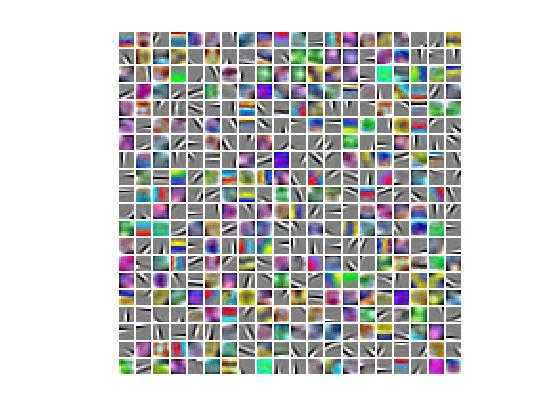标签:
Exercise:Learning color features with Sparse Autoencoders
习题链接:Exercise:Learning color features with Sparse Autoencoders
sparseAutoencoderLinearCost.m
function [cost,grad] = sparseAutoencoderLinearCost(theta, visibleSize, hiddenSize, ... lambda, sparsityParam, beta, data) % visibleSize: the number of input units (probably 64) % hiddenSize: the number of hidden units (probably 25) % lambda: weight decay parameter % sparsityParam: The desired average activation for the hidden units (denoted in the lecture % notes by the greek alphabet rho, which looks like a lower-case "p"). % beta: weight of sparsity penalty term % data: Our 64x10000 matrix containing the training data. So, data(:,i) is the i-th training example. % The input theta is a vector (because minFunc expects the parameters to be a vector). % We first convert theta to the (W1, W2, b1, b2) matrix/vector format, so that this % follows the notation convention of the lecture notes. % W1(i,j) denotes the weight from j_th node in input layer to i_th node % in hidden layer. Thus it is a hiddenSize*visibleSize matrix W1 = reshape(theta(1:hiddenSize*visibleSize), hiddenSize, visibleSize); % W2(i,j) denotes the weight from j_th node in hidden layer to i_th node % in output layer. Thus it is a visibleSize*hiddenSize matrix W2 = reshape(theta(hiddenSize*visibleSize+1:2*hiddenSize*visibleSize), visibleSize, hiddenSize); % b1(i) denotes the i_th bias in input layer to i_th node in hidden layer. % Thus it is a hiddenSize*1 vector b1 = theta(2*hiddenSize*visibleSize+1:2*hiddenSize*visibleSize+hiddenSize); % b2(i) denotes the i_th bias in hidden layer to i_th node in output layer. % Thus it is a visibleSize*1 vector b2 = theta(2*hiddenSize*visibleSize+hiddenSize+1:end); %% ---------- YOUR CODE HERE -------------------------------------- % Instructions: Compute the cost/optimization objective J_sparse(W,b) for the Sparse Autoencoder, % and the corresponding gradients W1grad, W2grad, b1grad, b2grad. % % W1grad, W2grad, b1grad and b2grad should be computed using backpropagation. % Note that W1grad has the same dimensions as W1, b1grad has the same dimensions % as b1, etc. Your code should set W1grad to be the partial derivative of J_sparse(W,b) with % respect to W1. I.e., W1grad(i,j) should be the partial derivative of J_sparse(W,b) % with respect to the input parameter W1(i,j). Thus, W1grad should be equal to the term % [(1/m) \Delta W^{(1)} + \lambda W^{(1)}] in the last block of pseudo-code in Section 2.2 % of the lecture notes (and similarly for W2grad, b1grad, b2grad). % % Stated differently, if we were using batch gradient descent to optimize the parameters, % the gradient descent update to W1 would be W1 := W1 - alpha * W1grad, and similarly for W2, b1, b2. % % 1. Set \Delta W^{(1)}, \Delta b^{(1)} to 0 for all layer l % Cost and gradient variables (your code needs to compute these values). % Here, we initialize them to zeros. W1grad = zeros(size(W1)); W2grad = zeros(size(W2)); b1grad = zeros(size(b1)); b2grad = zeros(size(b2)); m = size(data,2); % For small data, save activation information during computing rho % 2a. Use backpropagation to compute diff(J_sparse(W,b;x,y), W^{(1)}) % and diff(J_sparse(W,b;x,y), b^{(1)}) % 2a.1. Perform a feedforward pass, computing the activations for % hidden layer and output layer. % z2 is a hiddenSize*m matrix z2 = W1*data + repmat(b1,1,m); % a2 is a hiddenSize*m matrix a2 = sigmoid(z2); % z3 is a visibleSize*m matrix z3 = W2*a2 + repmat(b2,1,m); % a3 is a visibleSize*m matrix a3 = z3; % rho is a hiddenSize*1 vector rho = sum(a2,2); rho = rho ./ m; % KLterm is a hiddenSize*1 vector KLterm = beta*(-sparsityParam ./ rho + (1-sparsityParam) ./ (1-rho)); % Accumulate the cost cost = 1/2 * sum(sum((data-a3).*(data-a3))); % 2a.2. For the output layer, set delta3 % delta3 is a visibleSize*m matrix delta3 = -(data-a3); % 2a.3. For the hidden layer, set delta2 % delta2 is a hiddenSize*m matrix delta2 = (W2‘*delta3 + repmat(KLterm,1,m)) .* sigmoidDiff(z2); % 2a.4. Compute the desired partial derivatives % JW1diff is a hiddenSize*visibleSize matrix JW1diff = delta2 * data‘; % Jb1diff is a hiddenSize*m matrix Jb1diff = delta2; % JW2diff is a visibleSize*hiddenSize matrix JW2diff = delta3 * a2‘; % Jb1diff is a visibleSize*m matrix Jb2diff = delta3; % 2b. Update \Delta W^{(1)} W1grad = W1grad + JW1diff; W2grad = W2grad + JW2diff; % 2c. Update \Delta b^{(1)} b1grad = b1grad + sum(Jb1diff,2); b2grad = b2grad + sum(Jb2diff,2); % Compute KL penalty term KLpen = beta * sum(sparsityParam*log(sparsityParam ./ rho) + (1-sparsityParam)*log((1-sparsityParam) ./ (1-rho))); % Compute weight decay term tempW1 = W1 .* W1; tempW2 = W2 .* W2; WD = (lambda/2)*(sum(sum(tempW1))+sum(sum(tempW2))); cost = cost ./ m + WD + KLpen; W1grad = W1grad ./ m + lambda .* W1; W2grad = W2grad ./ m + lambda .* W2; b1grad = b1grad ./ m; b2grad = b2grad ./ m; %------------------------------------------------------------------- % 3.Update the parametersAfter computing the cost and gradient, we will % convert the gradients back to a vector format (suitable for minFunc). % Specifically, we will unroll your gradient matrices into a vector. grad = [W1grad(:) ; W2grad(:) ; b1grad(:) ; b2grad(:)]; end %------------------------------------------------------------------- % Here‘s an implementation of the sigmoid function, which you may find useful % in your computation of the costs and the gradients. This inputs a (row or % column) vector (say (z1, z2, z3)) and returns (f(z1), f(z2), f(z3)). function sigm = sigmoid(x) sigm = 1 ./ (1 + exp(-x)); end % define the differential of sigmoid function sigmDiff = sigmoidDiff(x) sigmDiff = sigmoid(x) .* (1-sigmoid(x)); end
结果:

如果跑出来是这样的,可能是把a3 = z3写成了a3 = sigmoid(z3)

【DeepLearning】Exercise:Learning color features with Sparse Autoencoders
标签:
原文地址:http://www.cnblogs.com/ganganloveu/p/4218111.html